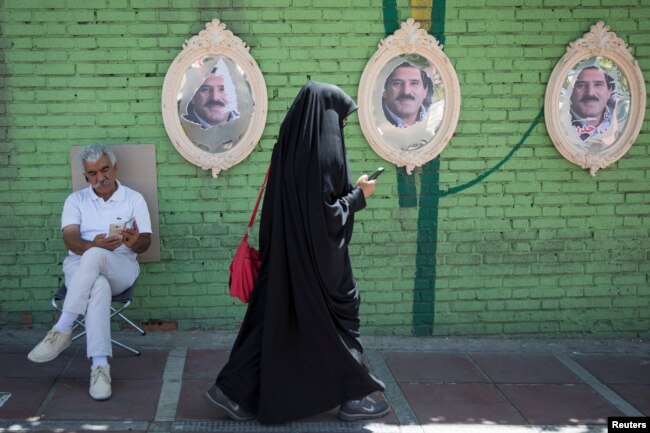RFL/RE – Iran’s authorities wasted little time squelching their citizens’ favorite social media as protests multiplied in December — including slapping “temporary” blocks on encrypted international apps like Telegram and Instagram, in addition to existing obstacles to Internet access.

Such steps paled in comparison to reports of protester deaths in the streets and in custody, thousands of arrests, and official denunciations of demonstrators as puppets of foreign “enemies.”
But officials are convinced that the digital clampdown helped extinguish the outbreaks of simmering popular anger at the politico-religious establishment in more than 90 cities and towns.
“Cyberspace was kindling the fire of the battle,” cleric Ahmad Khatami told worshipers at Friday Prayers in the Iranian capital on January 5, with reports of unrest waning. “Once cyberspace was restricted and closed down, the sedition was stopped.”
Khatami went on to call for a “cybernetwork” with servers inside Iran in order to avoid leaving the digital “key in the hands of the United States.”
“And you should manage it,” he added.
READ MORE: Cyberweapons Now A ‘Core Tool’ Of Iranian Statecraft
The lesson does not appear to have been lost on Iran’s political elite.
There is a fresh push by officials to promote homegrown social-media apps as an alternative to the wildly popular digital tools that helped fuel the unrest in December and January, the country’s biggest in nearly a decade.
This week, President Hassan Rohani reportedly instructed his communications minister to seriously pursue possible investment and support for domestic apps.
“It’s not acceptable for people to use a monopolized social media,” Rohani’s chief of staff, Mahmud Vaezi, told reporters on January 17, after the president issued the instruction at a cabinet meeting. “It is, of course, people’s right to use social-media networks. But with regard to [Iran’s] national security, there can’t be only one network.”
Rohani’s order follows years of intermittent calls by hard-liners “to secure” cyberspace, which remains difficult to police in part due to Iranians’ widespread use of antifiltering technology.
Telegram is thought to be used by around half of Iran’s 82 million people, and the photo-sharing app Instagram is also said to be popular as the use of smartphones and other mobile technology explodes.
On January 15, around 170 Iranian lawmakers blamed foreign apps for a host of ills, including the recent protests, a 2017 attack on parliament claimed by the militant Sunni group Islamic State (IS), and drug trafficking.
The parliamentarians said Iran’s enemies have taken advantage of foreign apps to hurt the country, and they called on the heads of all three branches of Iran’s government to replace foreign apps with domestic alternatives.
I think China definitely represents a model, which is to be able to diminish the reliance of the country on external services and to do so specifically for political motivations.”— Collin Anderson, Internet researcher
A similar call also came from the deputy commander for cultural and social affairs of the powerful Islamic Revolutionary Guards Corps (IRGC), a branch of the armed forces.
“Why are we supporting Russian and American youth instead of creating jobs for young Iranian experts active in this sphere?” Mohammad Reza Naghdi, a former head of the IRGC’s volunteer Basij militia, wrote in a letter to Rohani. “Tomorrow may be too late.”
Early in January, Iran’s highest authority, Supreme Leader Ayatollah Khamenei, announced via Telegram the launch of his own feed on two Iranian messaging applications, iGap and Soroush.
The London-based Small Media Foundation, which specializes in human rights projects, said in a recent report that Khamenei’s move appears to signal “an aggressive new drive” to push Iranian users toward domestic communication apps.
“These are all a reaction to the recent [unrest], but in general there have been similar moves and pushes periodically under previous administrations,” said Internet security researcher Amin Sabeti, who co-authored the report.
“For example, a few years ago national search engines were very hot…. At one point, [Iranian authorities] spoke about launching a national ‘Google Earth,'” Sabeti added. “But in reality none of these initiatives has been successful.
“People don’t trust [the authorities] — especially those who are politically active or in other areas such as fashion,” he added.
Fear of state surveillance appears to be a main driver of the distrust that has been acknowledged by authorities.
“According to the [Iranian] constitution, phone tapping can be conducted only in special cases with a judicial order,” Iranian lawmaker Fatemeh Saeedi told the Hamdeli daily on January 13. “The reason we see that domestic messaging applications are not popular today is a lack of trust.”
Collin Anderson, a U.S.-based independent Internet researcher who has studied Iranian policy and cybersecurity for years, said Iranians are right to be concerned about homegrown social-media apps.
“It seems that a lot of this push is in order to push users’ data into companies that will comply with local judicial orders in request for users’ data,” Anderson said.
“At the same time, I think even more functionally we have to be concerned about the applications themselves — in that when we start to look at the quality of the applications, the design principles, how they take into consideration user privacy and user security, there’s really no culture within those [Iranian] development companies of really respecting users, so the applications that they produce are highly insecure and dangerous, even outside the question of who owns the data,” he added.
Anderson said Iran’s authorities appear to be pursuing the Chinese model of strict Internet control.
“I think China definitely represents a model, which is to be able to diminish the reliance of the country on external services and to do so specifically for political motivations,” Anderson told RFE/RL.
In Tehran, a 44-year-old mother of two, who did not want her name published for fear of retribution, told RFE/RL that she refuses to use homegrown social-media apps.
“I don’t trust them, and I don’t know anyone in my entourage who uses them,” she said. “Even when [authorities] blocked Telegram, I kept using it through a VPN (virtual private network).”
 Shabtabnews In this dark night, I have lost my way – Arise from a corner, oh you the star of guidance.
Shabtabnews In this dark night, I have lost my way – Arise from a corner, oh you the star of guidance.




